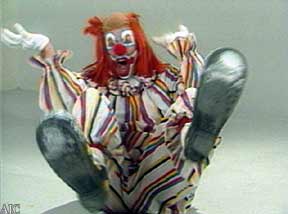 |
Edited by Janet Kraynak
The MIT Press
0-262-14082-9
420 pages

Nauman claims, in the extensive 1980 autobiographical interview by Michele de Angelus, that he knew very little about Marcel Duchamp’s affinity for puns when creating his own semantically slippery conceptual art style: “MD: You found out about that later? Like the Mona Lisa, L.H.O.O.Q… BN: I think that we all saw all those letters written there but I don’t think anybody ever explained it and I never asked.” (233) Nauman’s eerily intuitive way of creating sophisticated, intellectually angular art out of simple gestures –a ten minute film of himself bouncing balls in a studio and titled “Bouncing Two Balls between the Floor and Ceiling with Changing Rhythms,” for example – relies on the dry matter-of-factness about his language as it is placed in juxtaposition to a confounding visual element, often something whose fascination is never offset by the blandness inherent in repetition or naive craft. He is nearly a poet in this sense – his neon spiral “The True Artist Helps the World by Revealing Mystic Truths,” for example, has the uncanny resonance to neon works of the Scottish concretist Ian Hamilton Finlay – and yet, again and again in these interviews, he makes very few claims to an intellectual – and certainly not “postmodern” – agenda, despite his wide reading in such writers as Wittgenstein, Nabokov, and Beckett. The 1972 interview with Lorraine Sciarra has him confessing to not having heard of Merleau-Ponty even though, she states, several critics have insisted his work responds to the French philosopher’s ideas. Instead, Nauman – who, despite the occasionally violent or sadistic nature of his art, seems most concerned with creating beautiful, contemplative, and often "interactive" experiences – discusses how “a book called Gestalt Therapy [was] very important because it has to do with awareness of you body and a way of thinking about it […] I think what happens is you get sort of interested in something and then something else, someone, or some book, comes along that makes what you are doing more clear to you, and you can proceed more easily.” (166) Such formulations might be disappointing to a reader looking for a West Coast version of the ambitious essayist Robert Smithson, or – accepting simplicity and reticence – a Warholian spirit of enigma or Fluxus-inspired loyalty to trumping the bourgeois. Perhaps his nearest analog might be with the worldly and sage-like Brian Eno, someone who courts extreme, even clinical, thinking, if only as a way to achieve practical and reliable experiences in art, as when Nauman summarily comments on his use of puns: “I think humor is used a lot of the time to keep people from getting too close. Humor side-steps and shifts the meaning.” (193)
Of the group of nineteen artist writings in this book – mostly instructions for repetitive performance pieces that take the viewer/reader on experiential voyages that are difficult or nearly impossible to create, reflection of his appreciation of his friend LaMonte Young’s minimalist compositions which can potentially run for eternity – about nine haven’t been previously published in last year’s Art + Performance volume on Nauman (one of these, a cheeky comment on “earth art,” was intended to be skywritten and is a single line: “Leave the Land Alone”). Five of the interviews also appeared in that volume, which leaves nine exclusive to Please Pay Attention Please, one of which – the 100-pages by de Angelus – has never before appeared in complete form. The long introduction by Kraynak is satisfactory in its marshaling of basic semantic theory to explain Nauman’s relationship to words, and his words to their contexts, but lacks the cathartic insights one might expect in such a tight focus on his language, and utterly avoids the issue of Nauman’s relation to other conceptual artists who use words extensively -- she references Bakhtin and Benveniste over Rusche or Holzer -- this in lieu of the 27 essays and reviews that appear in the Art + Performance volume. Nauman is mild and reticent as an interviewee – he rarely answers a question beyond what is being asked – yet this volume is necessary for anyone wishing to get behind the ideas of his art, even if it duplicates much of the recent John Hopkins volume and is nearly twice as expensive.
(Image courtesy: The Art Institute of Chicago: Art Access.)
Posted by Brian Stefans at August 21, 2003 05:54 PM | TrackBackThe Stack is just what it sounds like: a tower of things that starts at the bottom and builds upward as it goes. In our case, the things in the stack are called "Stack Frames" or just "frames". We start with one stack frame at the very bottom, and we build up from there.
Posted by: Lewis at January 18, 2004 09:17 PM